Financial Management: Project Evaluation, WACC, and Financing
VerifiedAdded on 2021/06/15
|9
|1728
|37
Homework Assignment
AI Summary
This financial management assignment addresses three key questions. The first involves a Net Present Value (NPV) analysis of a project, considering revenue, costs, initial investments, salvage values, depreciation, capital gains, and tax implications to determine project feasibility. The second question focuses on calculating the Weighted Average Cost of Capital (WACC), requiring the determination of after-tax costs for various financing sources (preference shares, ordinary shares using CAPM, and bonds) and their respective market values to arrive at the WACC. The final question explores factors a company should consider when selecting short-term financing, including the cost of financing, collateral requirements, and the overhead costs associated with raising funds, providing a comprehensive understanding of financial decision-making. The solution utilizes formulas and calculations to support the analysis and includes references from financial management textbooks.
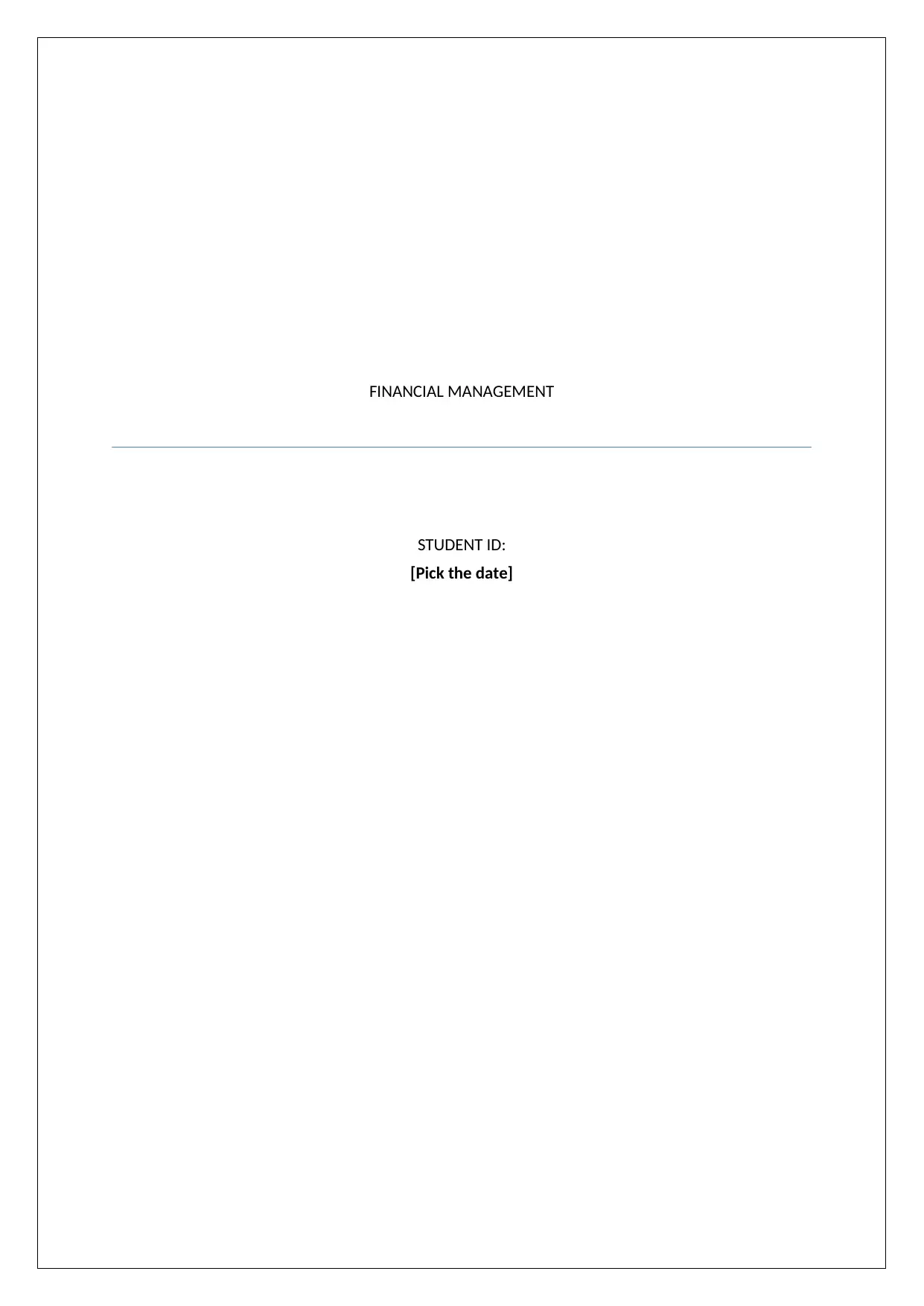
FINANCIAL MANAGEMENT
STUDENT ID:
[Pick the date]
STUDENT ID:
[Pick the date]
Paraphrase This Document
Need a fresh take? Get an instant paraphrase of this document with our AI Paraphraser
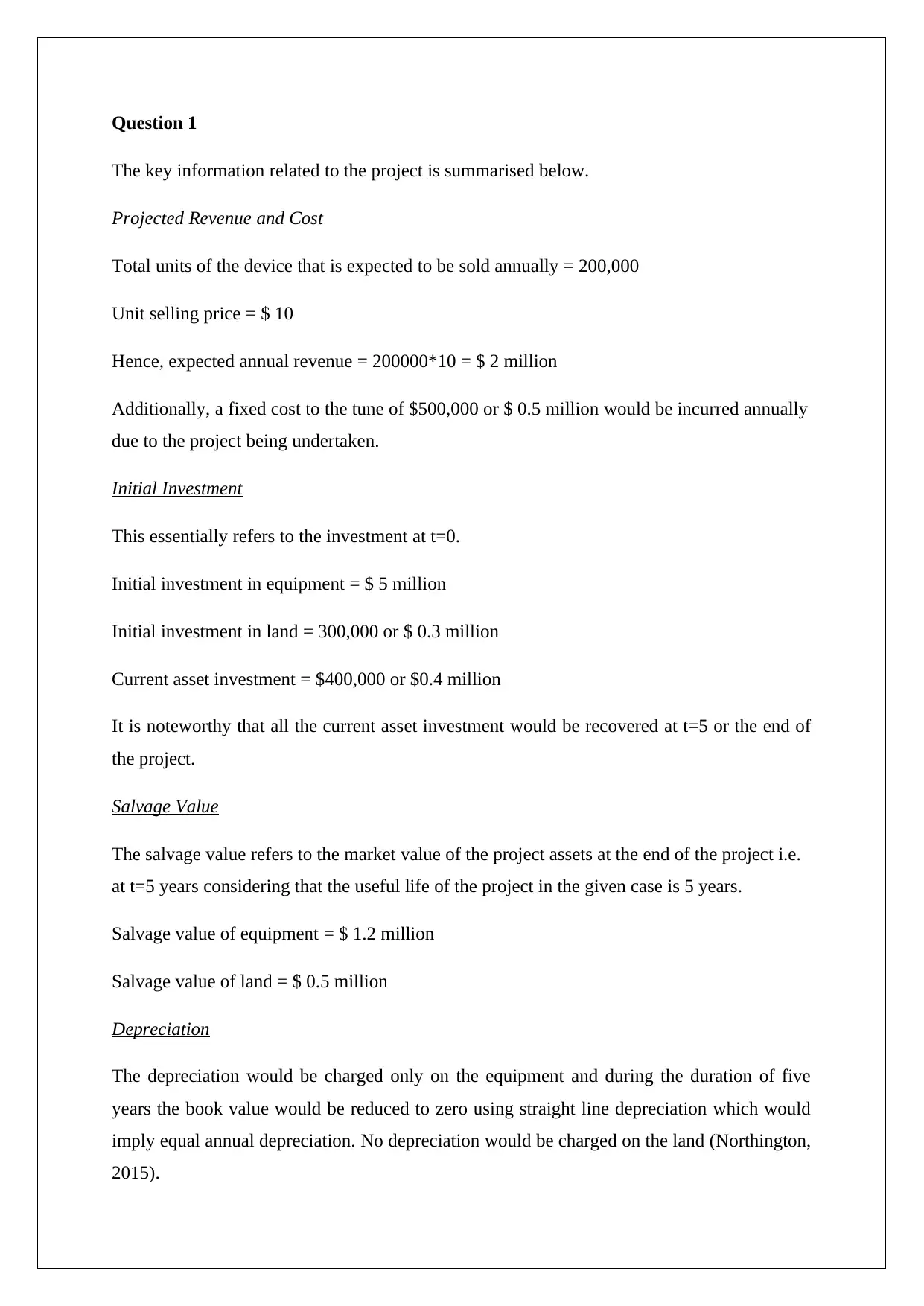
Question 1
The key information related to the project is summarised below.
Projected Revenue and Cost
Total units of the device that is expected to be sold annually = 200,000
Unit selling price = $ 10
Hence, expected annual revenue = 200000*10 = $ 2 million
Additionally, a fixed cost to the tune of $500,000 or $ 0.5 million would be incurred annually
due to the project being undertaken.
Initial Investment
This essentially refers to the investment at t=0.
Initial investment in equipment = $ 5 million
Initial investment in land = 300,000 or $ 0.3 million
Current asset investment = $400,000 or $0.4 million
It is noteworthy that all the current asset investment would be recovered at t=5 or the end of
the project.
Salvage Value
The salvage value refers to the market value of the project assets at the end of the project i.e.
at t=5 years considering that the useful life of the project in the given case is 5 years.
Salvage value of equipment = $ 1.2 million
Salvage value of land = $ 0.5 million
Depreciation
The depreciation would be charged only on the equipment and during the duration of five
years the book value would be reduced to zero using straight line depreciation which would
imply equal annual depreciation. No depreciation would be charged on the land (Northington,
2015).
The key information related to the project is summarised below.
Projected Revenue and Cost
Total units of the device that is expected to be sold annually = 200,000
Unit selling price = $ 10
Hence, expected annual revenue = 200000*10 = $ 2 million
Additionally, a fixed cost to the tune of $500,000 or $ 0.5 million would be incurred annually
due to the project being undertaken.
Initial Investment
This essentially refers to the investment at t=0.
Initial investment in equipment = $ 5 million
Initial investment in land = 300,000 or $ 0.3 million
Current asset investment = $400,000 or $0.4 million
It is noteworthy that all the current asset investment would be recovered at t=5 or the end of
the project.
Salvage Value
The salvage value refers to the market value of the project assets at the end of the project i.e.
at t=5 years considering that the useful life of the project in the given case is 5 years.
Salvage value of equipment = $ 1.2 million
Salvage value of land = $ 0.5 million
Depreciation
The depreciation would be charged only on the equipment and during the duration of five
years the book value would be reduced to zero using straight line depreciation which would
imply equal annual depreciation. No depreciation would be charged on the land (Northington,
2015).
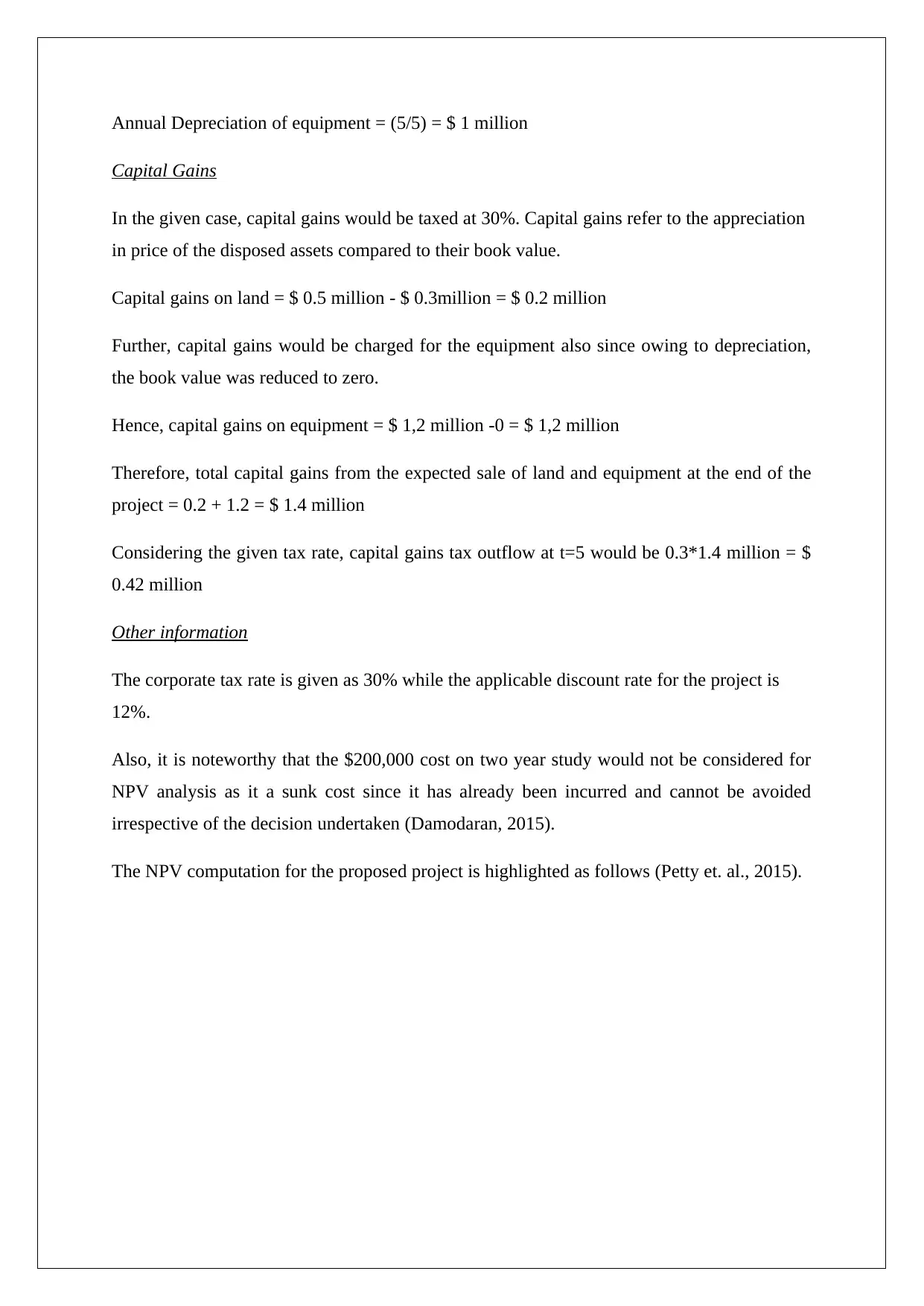
Annual Depreciation of equipment = (5/5) = $ 1 million
Capital Gains
In the given case, capital gains would be taxed at 30%. Capital gains refer to the appreciation
in price of the disposed assets compared to their book value.
Capital gains on land = $ 0.5 million - $ 0.3million = $ 0.2 million
Further, capital gains would be charged for the equipment also since owing to depreciation,
the book value was reduced to zero.
Hence, capital gains on equipment = $ 1,2 million -0 = $ 1,2 million
Therefore, total capital gains from the expected sale of land and equipment at the end of the
project = 0.2 + 1.2 = $ 1.4 million
Considering the given tax rate, capital gains tax outflow at t=5 would be 0.3*1.4 million = $
0.42 million
Other information
The corporate tax rate is given as 30% while the applicable discount rate for the project is
12%.
Also, it is noteworthy that the $200,000 cost on two year study would not be considered for
NPV analysis as it a sunk cost since it has already been incurred and cannot be avoided
irrespective of the decision undertaken (Damodaran, 2015).
The NPV computation for the proposed project is highlighted as follows (Petty et. al., 2015).
Capital Gains
In the given case, capital gains would be taxed at 30%. Capital gains refer to the appreciation
in price of the disposed assets compared to their book value.
Capital gains on land = $ 0.5 million - $ 0.3million = $ 0.2 million
Further, capital gains would be charged for the equipment also since owing to depreciation,
the book value was reduced to zero.
Hence, capital gains on equipment = $ 1,2 million -0 = $ 1,2 million
Therefore, total capital gains from the expected sale of land and equipment at the end of the
project = 0.2 + 1.2 = $ 1.4 million
Considering the given tax rate, capital gains tax outflow at t=5 would be 0.3*1.4 million = $
0.42 million
Other information
The corporate tax rate is given as 30% while the applicable discount rate for the project is
12%.
Also, it is noteworthy that the $200,000 cost on two year study would not be considered for
NPV analysis as it a sunk cost since it has already been incurred and cannot be avoided
irrespective of the decision undertaken (Damodaran, 2015).
The NPV computation for the proposed project is highlighted as follows (Petty et. al., 2015).
⊘ This is a preview!⊘
Do you want full access?
Subscribe today to unlock all pages.

Trusted by 1+ million students worldwide
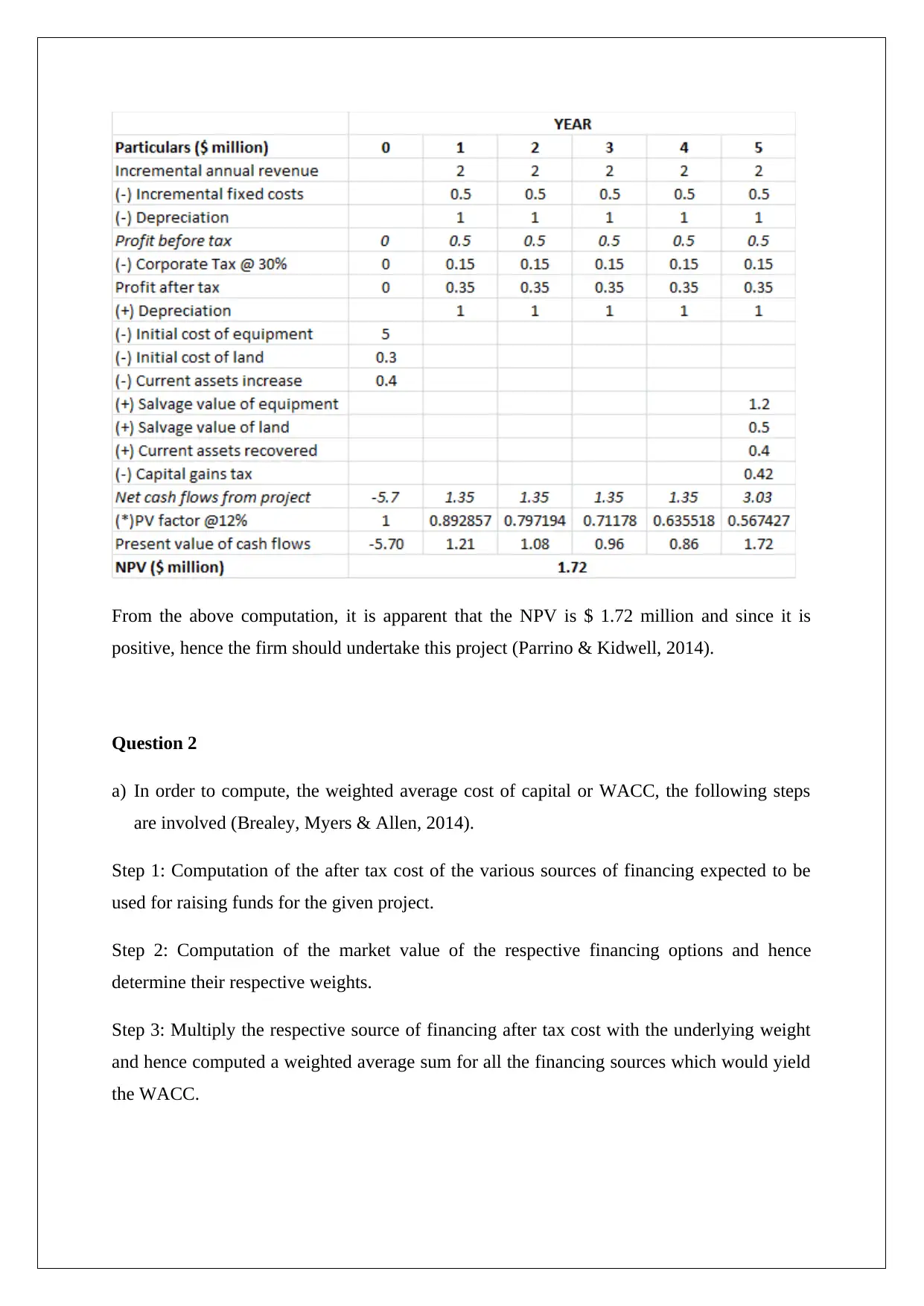
From the above computation, it is apparent that the NPV is $ 1.72 million and since it is
positive, hence the firm should undertake this project (Parrino & Kidwell, 2014).
Question 2
a) In order to compute, the weighted average cost of capital or WACC, the following steps
are involved (Brealey, Myers & Allen, 2014).
Step 1: Computation of the after tax cost of the various sources of financing expected to be
used for raising funds for the given project.
Step 2: Computation of the market value of the respective financing options and hence
determine their respective weights.
Step 3: Multiply the respective source of financing after tax cost with the underlying weight
and hence computed a weighted average sum for all the financing sources which would yield
the WACC.
positive, hence the firm should undertake this project (Parrino & Kidwell, 2014).
Question 2
a) In order to compute, the weighted average cost of capital or WACC, the following steps
are involved (Brealey, Myers & Allen, 2014).
Step 1: Computation of the after tax cost of the various sources of financing expected to be
used for raising funds for the given project.
Step 2: Computation of the market value of the respective financing options and hence
determine their respective weights.
Step 3: Multiply the respective source of financing after tax cost with the underlying weight
and hence computed a weighted average sum for all the financing sources which would yield
the WACC.
Paraphrase This Document
Need a fresh take? Get an instant paraphrase of this document with our AI Paraphraser
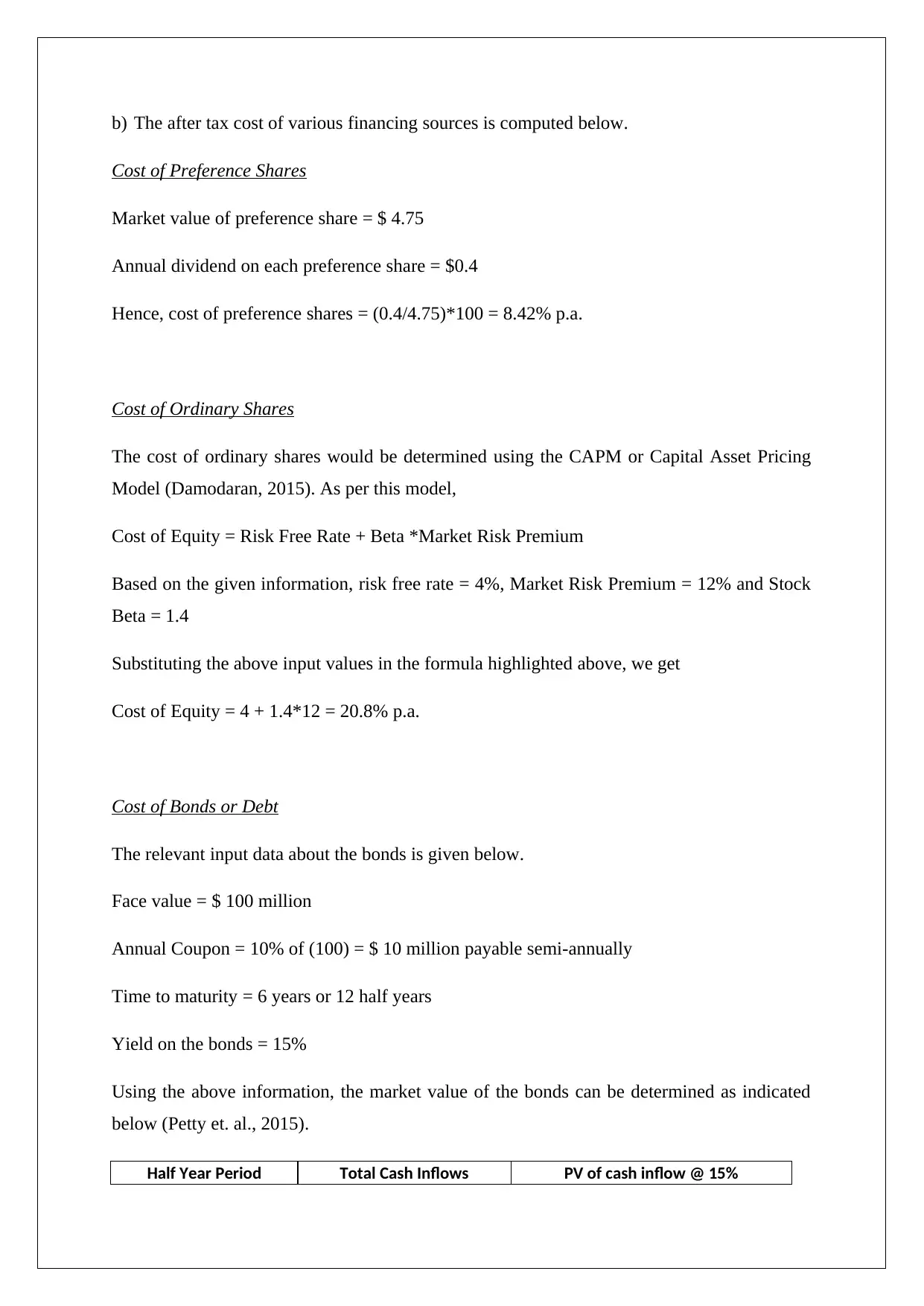
b) The after tax cost of various financing sources is computed below.
Cost of Preference Shares
Market value of preference share = $ 4.75
Annual dividend on each preference share = $0.4
Hence, cost of preference shares = (0.4/4.75)*100 = 8.42% p.a.
Cost of Ordinary Shares
The cost of ordinary shares would be determined using the CAPM or Capital Asset Pricing
Model (Damodaran, 2015). As per this model,
Cost of Equity = Risk Free Rate + Beta *Market Risk Premium
Based on the given information, risk free rate = 4%, Market Risk Premium = 12% and Stock
Beta = 1.4
Substituting the above input values in the formula highlighted above, we get
Cost of Equity = 4 + 1.4*12 = 20.8% p.a.
Cost of Bonds or Debt
The relevant input data about the bonds is given below.
Face value = $ 100 million
Annual Coupon = 10% of (100) = $ 10 million payable semi-annually
Time to maturity = 6 years or 12 half years
Yield on the bonds = 15%
Using the above information, the market value of the bonds can be determined as indicated
below (Petty et. al., 2015).
Half Year Period Total Cash Inflows PV of cash inflow @ 15%
Cost of Preference Shares
Market value of preference share = $ 4.75
Annual dividend on each preference share = $0.4
Hence, cost of preference shares = (0.4/4.75)*100 = 8.42% p.a.
Cost of Ordinary Shares
The cost of ordinary shares would be determined using the CAPM or Capital Asset Pricing
Model (Damodaran, 2015). As per this model,
Cost of Equity = Risk Free Rate + Beta *Market Risk Premium
Based on the given information, risk free rate = 4%, Market Risk Premium = 12% and Stock
Beta = 1.4
Substituting the above input values in the formula highlighted above, we get
Cost of Equity = 4 + 1.4*12 = 20.8% p.a.
Cost of Bonds or Debt
The relevant input data about the bonds is given below.
Face value = $ 100 million
Annual Coupon = 10% of (100) = $ 10 million payable semi-annually
Time to maturity = 6 years or 12 half years
Yield on the bonds = 15%
Using the above information, the market value of the bonds can be determined as indicated
below (Petty et. al., 2015).
Half Year Period Total Cash Inflows PV of cash inflow @ 15%
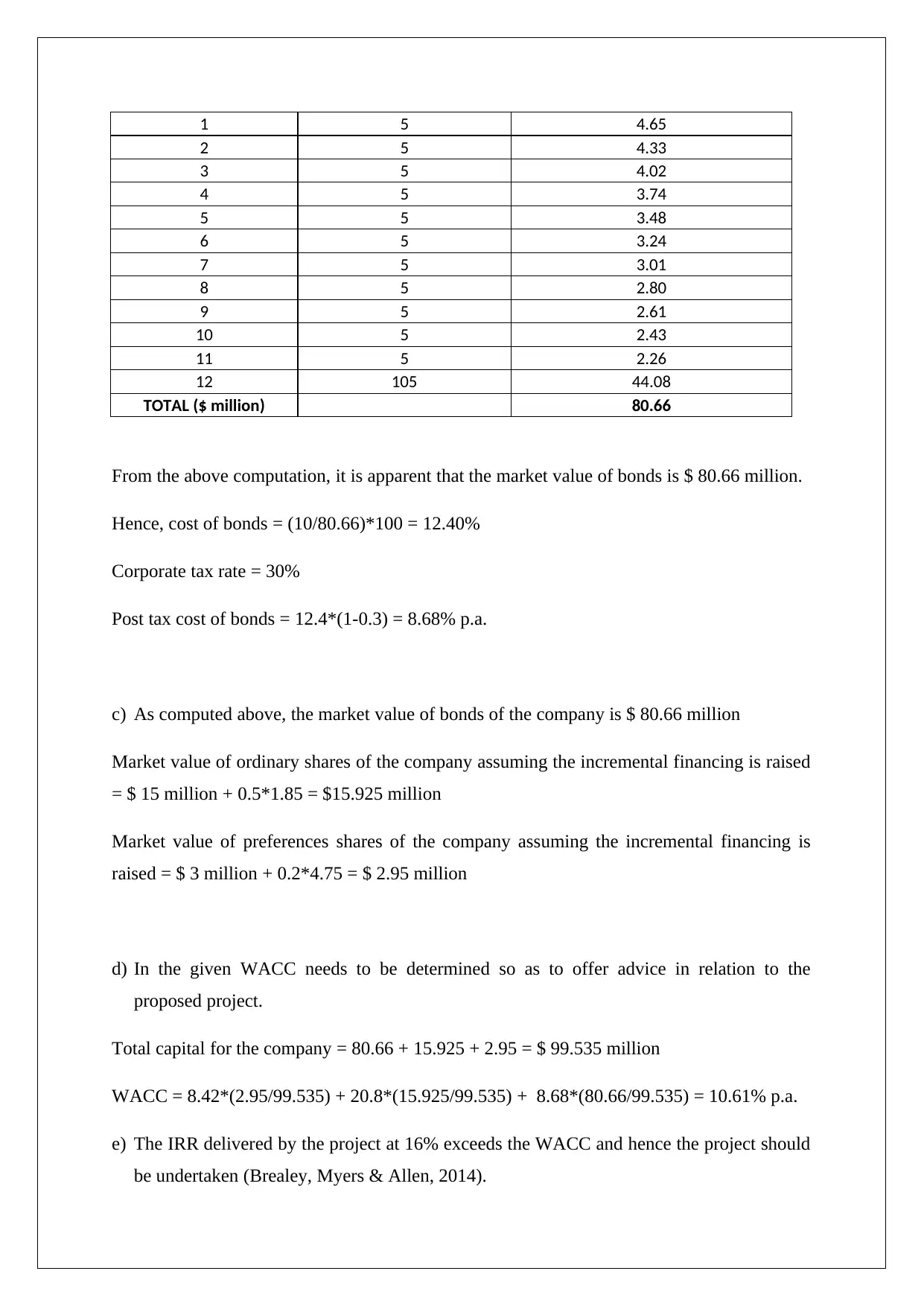
1 5 4.65
2 5 4.33
3 5 4.02
4 5 3.74
5 5 3.48
6 5 3.24
7 5 3.01
8 5 2.80
9 5 2.61
10 5 2.43
11 5 2.26
12 105 44.08
TOTAL ($ million) 80.66
From the above computation, it is apparent that the market value of bonds is $ 80.66 million.
Hence, cost of bonds = (10/80.66)*100 = 12.40%
Corporate tax rate = 30%
Post tax cost of bonds = 12.4*(1-0.3) = 8.68% p.a.
c) As computed above, the market value of bonds of the company is $ 80.66 million
Market value of ordinary shares of the company assuming the incremental financing is raised
= $ 15 million + 0.5*1.85 = $15.925 million
Market value of preferences shares of the company assuming the incremental financing is
raised = $ 3 million + 0.2*4.75 = $ 2.95 million
d) In the given WACC needs to be determined so as to offer advice in relation to the
proposed project.
Total capital for the company = 80.66 + 15.925 + 2.95 = $ 99.535 million
WACC = 8.42*(2.95/99.535) + 20.8*(15.925/99.535) + 8.68*(80.66/99.535) = 10.61% p.a.
e) The IRR delivered by the project at 16% exceeds the WACC and hence the project should
be undertaken (Brealey, Myers & Allen, 2014).
2 5 4.33
3 5 4.02
4 5 3.74
5 5 3.48
6 5 3.24
7 5 3.01
8 5 2.80
9 5 2.61
10 5 2.43
11 5 2.26
12 105 44.08
TOTAL ($ million) 80.66
From the above computation, it is apparent that the market value of bonds is $ 80.66 million.
Hence, cost of bonds = (10/80.66)*100 = 12.40%
Corporate tax rate = 30%
Post tax cost of bonds = 12.4*(1-0.3) = 8.68% p.a.
c) As computed above, the market value of bonds of the company is $ 80.66 million
Market value of ordinary shares of the company assuming the incremental financing is raised
= $ 15 million + 0.5*1.85 = $15.925 million
Market value of preferences shares of the company assuming the incremental financing is
raised = $ 3 million + 0.2*4.75 = $ 2.95 million
d) In the given WACC needs to be determined so as to offer advice in relation to the
proposed project.
Total capital for the company = 80.66 + 15.925 + 2.95 = $ 99.535 million
WACC = 8.42*(2.95/99.535) + 20.8*(15.925/99.535) + 8.68*(80.66/99.535) = 10.61% p.a.
e) The IRR delivered by the project at 16% exceeds the WACC and hence the project should
be undertaken (Brealey, Myers & Allen, 2014).
⊘ This is a preview!⊘
Do you want full access?
Subscribe today to unlock all pages.

Trusted by 1+ million students worldwide
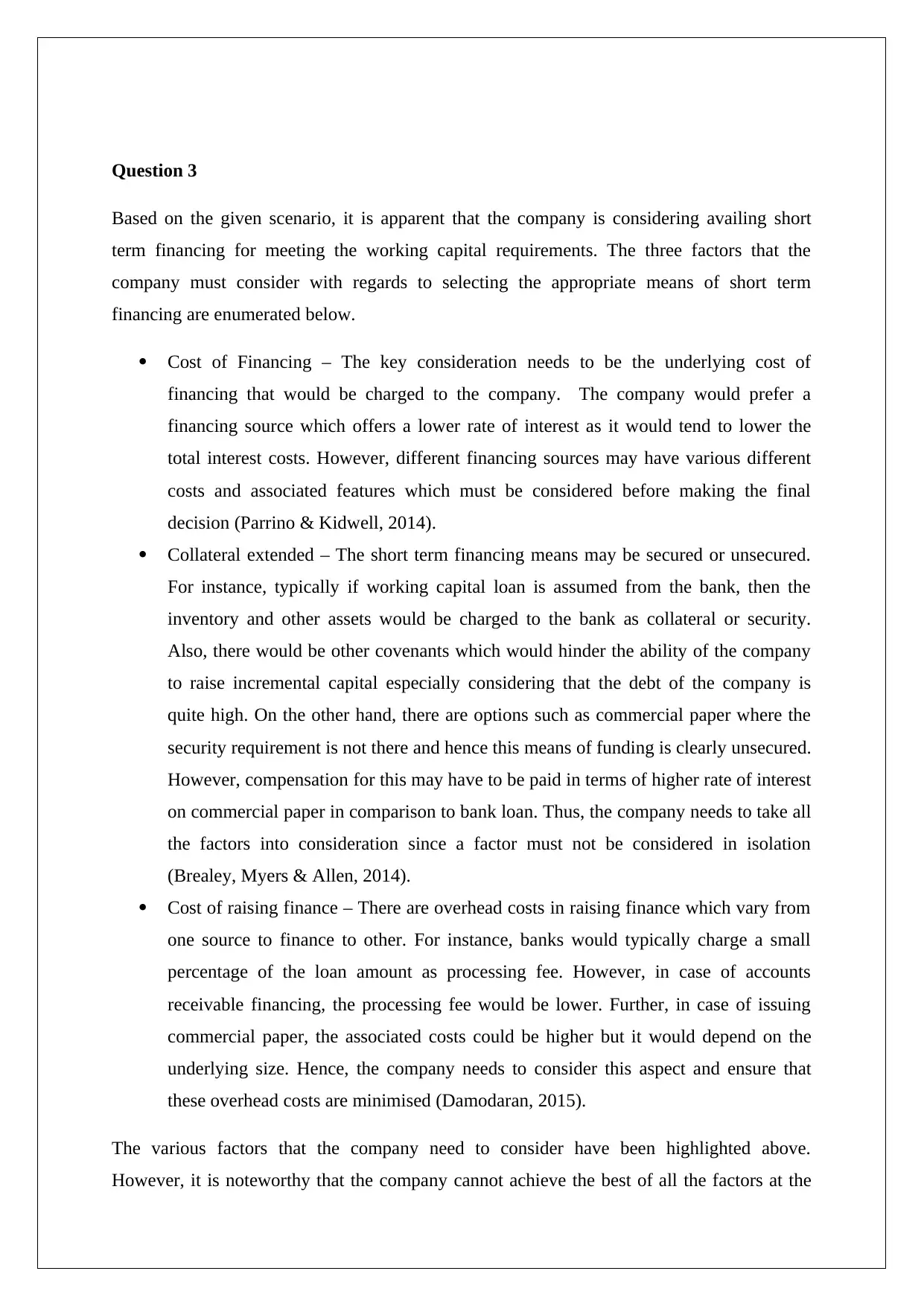
Question 3
Based on the given scenario, it is apparent that the company is considering availing short
term financing for meeting the working capital requirements. The three factors that the
company must consider with regards to selecting the appropriate means of short term
financing are enumerated below.
Cost of Financing – The key consideration needs to be the underlying cost of
financing that would be charged to the company. The company would prefer a
financing source which offers a lower rate of interest as it would tend to lower the
total interest costs. However, different financing sources may have various different
costs and associated features which must be considered before making the final
decision (Parrino & Kidwell, 2014).
Collateral extended – The short term financing means may be secured or unsecured.
For instance, typically if working capital loan is assumed from the bank, then the
inventory and other assets would be charged to the bank as collateral or security.
Also, there would be other covenants which would hinder the ability of the company
to raise incremental capital especially considering that the debt of the company is
quite high. On the other hand, there are options such as commercial paper where the
security requirement is not there and hence this means of funding is clearly unsecured.
However, compensation for this may have to be paid in terms of higher rate of interest
on commercial paper in comparison to bank loan. Thus, the company needs to take all
the factors into consideration since a factor must not be considered in isolation
(Brealey, Myers & Allen, 2014).
Cost of raising finance – There are overhead costs in raising finance which vary from
one source to finance to other. For instance, banks would typically charge a small
percentage of the loan amount as processing fee. However, in case of accounts
receivable financing, the processing fee would be lower. Further, in case of issuing
commercial paper, the associated costs could be higher but it would depend on the
underlying size. Hence, the company needs to consider this aspect and ensure that
these overhead costs are minimised (Damodaran, 2015).
The various factors that the company need to consider have been highlighted above.
However, it is noteworthy that the company cannot achieve the best of all the factors at the
Based on the given scenario, it is apparent that the company is considering availing short
term financing for meeting the working capital requirements. The three factors that the
company must consider with regards to selecting the appropriate means of short term
financing are enumerated below.
Cost of Financing – The key consideration needs to be the underlying cost of
financing that would be charged to the company. The company would prefer a
financing source which offers a lower rate of interest as it would tend to lower the
total interest costs. However, different financing sources may have various different
costs and associated features which must be considered before making the final
decision (Parrino & Kidwell, 2014).
Collateral extended – The short term financing means may be secured or unsecured.
For instance, typically if working capital loan is assumed from the bank, then the
inventory and other assets would be charged to the bank as collateral or security.
Also, there would be other covenants which would hinder the ability of the company
to raise incremental capital especially considering that the debt of the company is
quite high. On the other hand, there are options such as commercial paper where the
security requirement is not there and hence this means of funding is clearly unsecured.
However, compensation for this may have to be paid in terms of higher rate of interest
on commercial paper in comparison to bank loan. Thus, the company needs to take all
the factors into consideration since a factor must not be considered in isolation
(Brealey, Myers & Allen, 2014).
Cost of raising finance – There are overhead costs in raising finance which vary from
one source to finance to other. For instance, banks would typically charge a small
percentage of the loan amount as processing fee. However, in case of accounts
receivable financing, the processing fee would be lower. Further, in case of issuing
commercial paper, the associated costs could be higher but it would depend on the
underlying size. Hence, the company needs to consider this aspect and ensure that
these overhead costs are minimised (Damodaran, 2015).
The various factors that the company need to consider have been highlighted above.
However, it is noteworthy that the company cannot achieve the best of all the factors at the
Paraphrase This Document
Need a fresh take? Get an instant paraphrase of this document with our AI Paraphraser
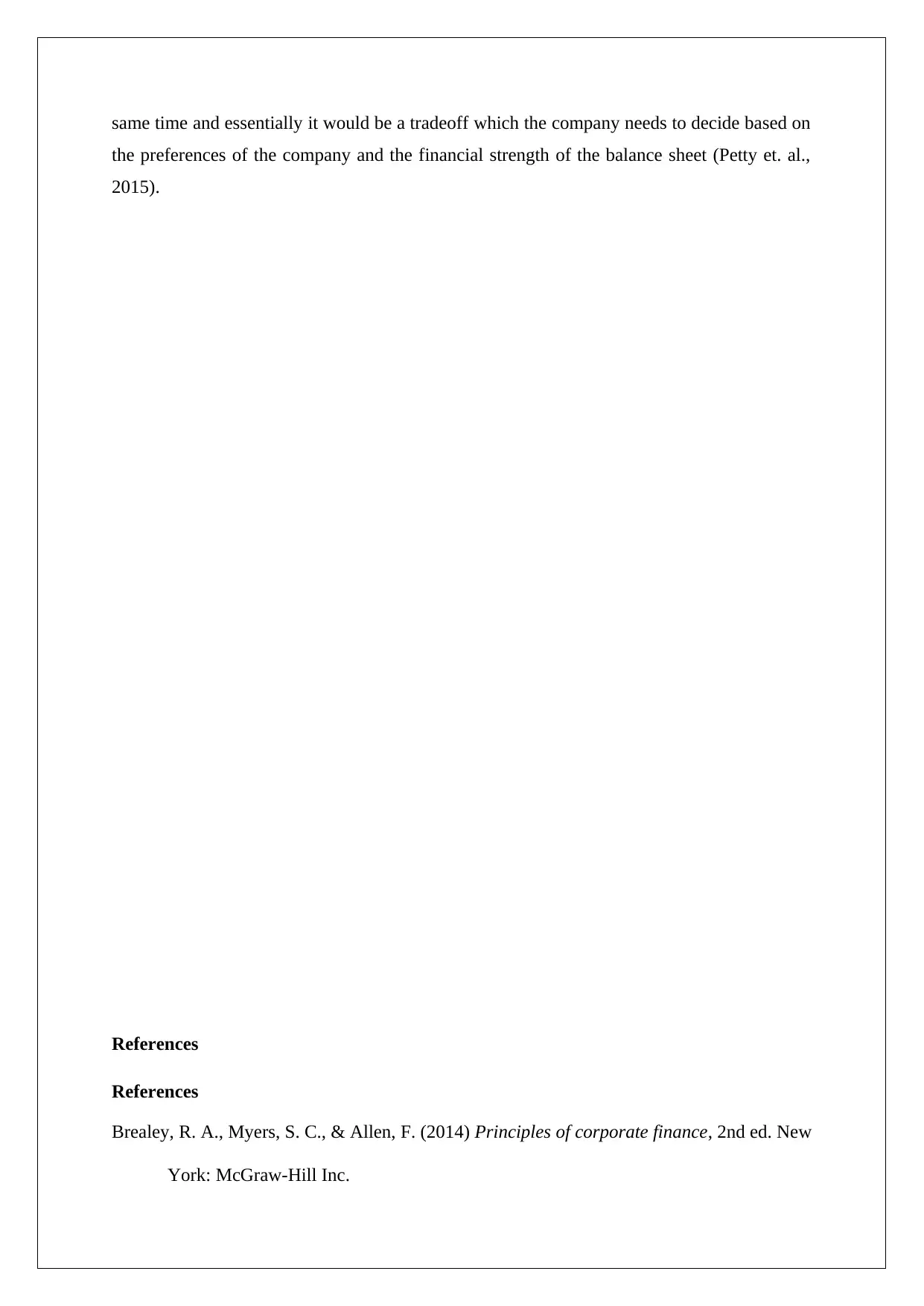
same time and essentially it would be a tradeoff which the company needs to decide based on
the preferences of the company and the financial strength of the balance sheet (Petty et. al.,
2015).
References
References
Brealey, R. A., Myers, S. C., & Allen, F. (2014) Principles of corporate finance, 2nd ed. New
York: McGraw-Hill Inc.
the preferences of the company and the financial strength of the balance sheet (Petty et. al.,
2015).
References
References
Brealey, R. A., Myers, S. C., & Allen, F. (2014) Principles of corporate finance, 2nd ed. New
York: McGraw-Hill Inc.
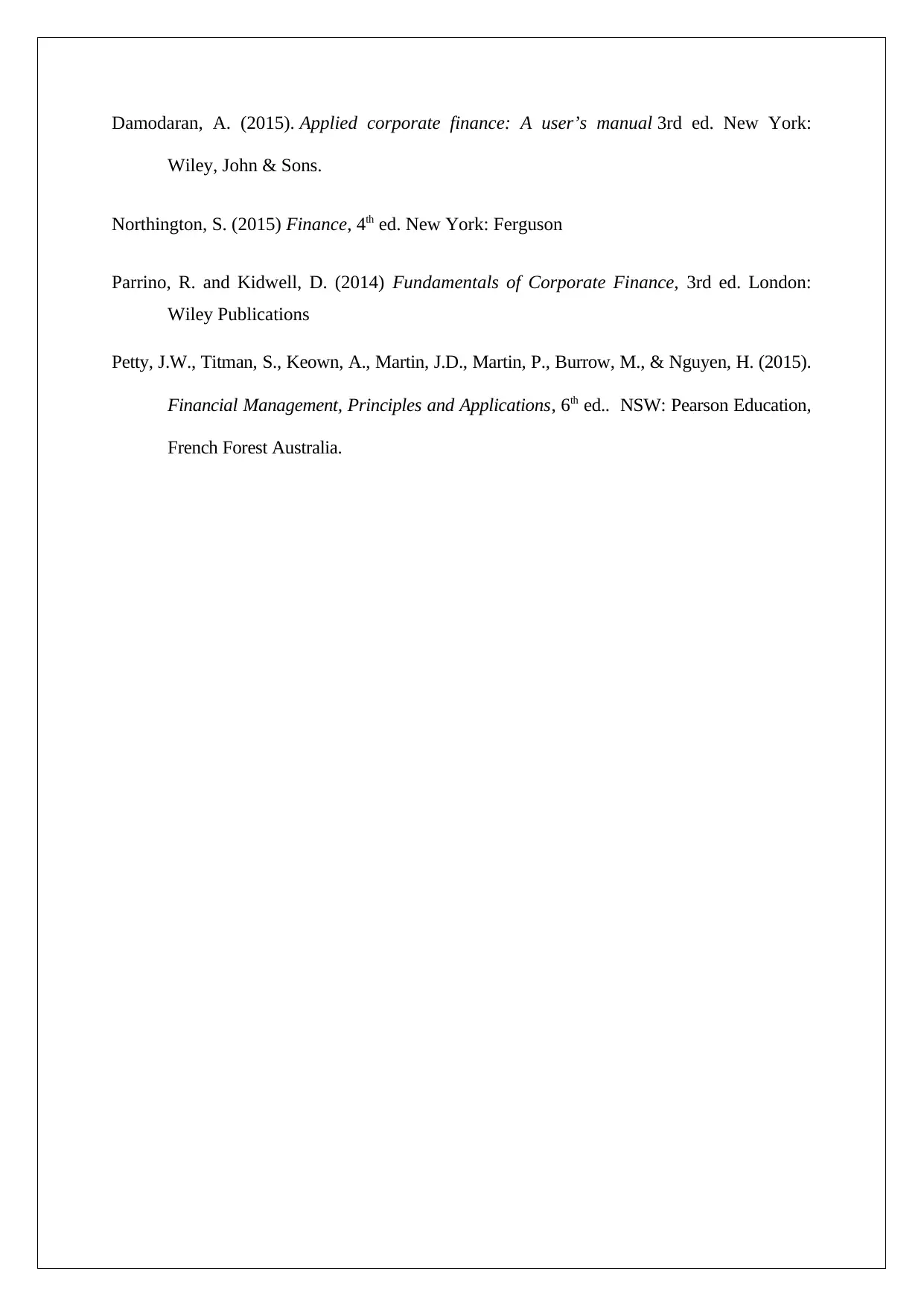
Damodaran, A. (2015). Applied corporate finance: A user’s manual 3rd ed. New York:
Wiley, John & Sons.
Northington, S. (2015) Finance, 4th ed. New York: Ferguson
Parrino, R. and Kidwell, D. (2014) Fundamentals of Corporate Finance, 3rd ed. London:
Wiley Publications
Petty, J.W., Titman, S., Keown, A., Martin, J.D., Martin, P., Burrow, M., & Nguyen, H. (2015).
Financial Management, Principles and Applications, 6th ed.. NSW: Pearson Education,
French Forest Australia.
Wiley, John & Sons.
Northington, S. (2015) Finance, 4th ed. New York: Ferguson
Parrino, R. and Kidwell, D. (2014) Fundamentals of Corporate Finance, 3rd ed. London:
Wiley Publications
Petty, J.W., Titman, S., Keown, A., Martin, J.D., Martin, P., Burrow, M., & Nguyen, H. (2015).
Financial Management, Principles and Applications, 6th ed.. NSW: Pearson Education,
French Forest Australia.
⊘ This is a preview!⊘
Do you want full access?
Subscribe today to unlock all pages.

Trusted by 1+ million students worldwide
1 out of 9
Related Documents
Your All-in-One AI-Powered Toolkit for Academic Success.
+13062052269
info@desklib.com
Available 24*7 on WhatsApp / Email
![[object Object]](/_next/static/media/star-bottom.7253800d.svg)
Unlock your academic potential
Copyright © 2020–2025 A2Z Services. All Rights Reserved. Developed and managed by ZUCOL.




